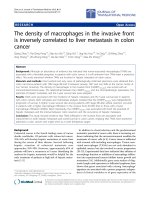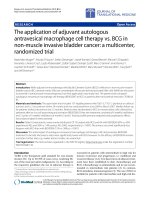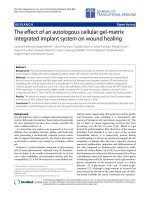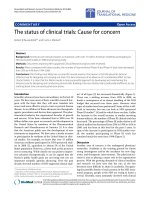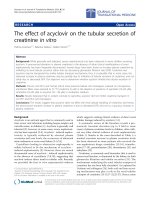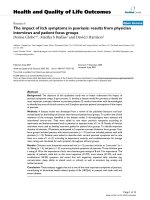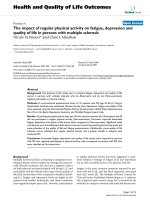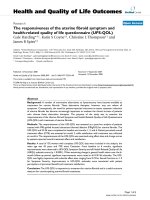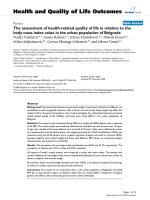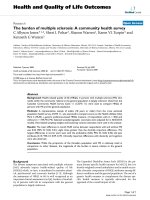Báo cáo hóa học: " The effect of an autologous cellular gel-matrix integrated implant system on wound healing" pot
Bạn đang xem bản rút gọn của tài liệu. Xem và tải ngay bản đầy đủ của tài liệu tại đây (1.31 MB, 11 trang )
Weinstein-Oppenheimer et al. Journal of Translational Medicine 2010, 8:59
/>Open Access
RESEARCH
© 2010 Weinstein-Oppenheimer et al; licensee BioMed Central Ltd. This is an Open Access article distributed under the terms of the
Creative Commons Attribution License ( which permits unrestricted use, distribution,
and reproduction in any medium, provided the original work is properly cited.
Research
The effect of an autologous cellular gel-matrix
integrated implant system on wound healing
Caroline R Weinstein-Oppenheimer*
1
, Alexis R Aceituno
2
, Donald I Brown
3
, Cristian Acevedo
4
, Ricardo Ceriani
5
,
Miguel A Fuentes
5
, Fernando Albornoz
4
, Carlos F Henríquez-Roldán
6,7
, Patricio Morales
8
, Claudio Maclean
9
,
Sergio M Tapia
5
and Manuel E Young
4
Abstract
Background: This manuscript reports the production and preclinical studies to examine the tolerance and efficacy of
an autologous cellular gel-matrix integrated implant system (IIS) aimed to treat full-thickness skin lesions.
Methods: The best concentration of fibrinogen and thrombin was experimentally determined by employing 28
formula ratios of thrombin and fibrinogen and checking clot formation and apparent stability. IIS was formed by
integrating skin cells by means of the in situ gelification of fibrin into a porous crosslinked scaffold composed of
chitosan, gelatin and hyaluronic acid. The in vitro cell proliferation within the IIS was examined by the MTT assay and
PCNA expression. An experimental rabbit model consisting of six circular lesions was utilized to test each of the
components of the IIS. Then, the IIS was utilized in an animal model to cover a 35% body surface full thickness lesion.
Results: The preclinical assays in rabbits demonstrated that the IIS was well tolerated and also that IIS-treated rabbit
with lesions of 35% of their body surface, exhibited a better survival rate (p = 0,06).
Conclusion: IIS should be further studied as a new wound dressing which shows promising properties, being the most
remarkable its good biological tolerance and cell growth promotion properties.
Background
Natural polymers such as collagens, glycosaminoglycans,
starch, chitin and chitosan have been used as biomaterials
for skin substitutes because they closely resemble the
native cellular milieu [1-3].
An interesting new matrix was proposed by Liu et al,
2004[4], that crosslinks chitosan, gelatin and hyaluronic
acid, generating a mechanically resistant porous matrix
able to support fibroblast growth. We choose this matrix
as the basis to build a new system by including a fibrin
gel.
Chitosan, a polysaccharide composed of glucosamine
and N-acetyl glucosamine, obtained from N- deacetyla-
tion of chitin, is an excellent biomaterial due to its low
cost, scale availability, anti-microbial activity and bio-
compatibility [5]. It has been used as a cross-linked scaf-
fold for tissue engineering with polymers such as gelatin
and hyaluronic acid, resulting in a biomaterial with
improved biological and mechanical properties [6]. The
use of fibrin in tissue engineering practices has been
increasing over the last 10 years [7-11]. Fibrin is a gel
formed by polymerization after the action of the enzyme
thrombin. Even though it is not a part of the normal
extracellular matrix, it is temporarily present during
wound healing [12]. Its use as a polymeric support for the
transplant of human skin has been reported showing
improved proliferation, migration and differentiation of
the cells compared to keratinocytes cultured in tradi-
tional cell culture flasks [3,8,13,14]. It was later reported
that keratinocytes cultured on fibrin maintain the cells on
a proliferative state and improves the take of the grafts
containing these cells [4]. Hyaluronic acid, a glicosamino-
glycan component of the connective tissue, is a linear
polymer of d-glucuronic acid and N-acetyl-D-glu-
cosamine [12]. Although a large amount of research has
been focused on the use of the cross linked type of chito-
san-based scaffolds for tissue constructs, the optimiza-
* Correspondence:
1
Departamento de Bioquímica, Facultad de Farmacia, Universidad de
Valparaíso, Avenida Gran Bretaña 1093, Playa Ancha Valparaíso, Casilla 5001-V,
Valparaíso, Chile
Full list of author information is available at the end of the article
Weinstein-Oppenheimer et al. Journal of Translational Medicine 2010, 8:59
/>Page 2 of 11
tion of cell seeding is a critical step for the successful in
vitro cultivation of artificial organs.
The aim of the present research was to investigate the
performance of a novel artificial skin chitosan- based
scaffold containing autologous skin cells that have been
included in a fibrin gel integrated inside the matrix. The
ultimate goal of this research was to explore the tolerance
and the efficacy of an IIS on an animal-based model.
Methods
Biopsies
Ortolagus cuniculus rabbits were anesthetized with ket-
amine/xylasine (5 mg and 2 mg/100 g of body weight)
[15]. A selected dorsal area was shaved and after disinfec-
tion with a povidone-iodine complex solution, a 1-cm
2
biopsy was taken. All the animal experiments and proce-
dures, including animal procurement, surgery, anesthe-
sia, euthanasia, animal housing and surgery facilities were
performed by veterinarians following the Facultad de Far-
macia-Universidad de Valparaíso animal care guidelines,
which are based on the Guide for the Care and Use of
Laboratory Animals from the National Research Coun-
cil[16].
Cell isolation and culture
The technique used for isolation and culture of skin cells
was adapted from previously published reports [17-19].
Briefly, the biopsy was washed three times with pH 7.4
0.1 M phosphate buffered saline (PBS) containing penicil-
lin (100 U/mL)/streptomycin (100 μg/mL). Visible fat was
mechanically removed and the remnant tissue was
minced with surgical blades to optimize enzymatic diges-
tion. Afterwards, epidermis was incubated with trypsine-
EDTA (0.05%-0.53 mM) and dermis with collagenase (2
mg/mL). Dermal and epidermal cells were washed in
DMEM and then fibroblasts were cultured in DMEM/
F12 and keratinocytes in Defined Keratinocytes Medium.
All the cell culture reagents were purchased from Invitro-
gen (Carisbad, CA, USA).
Cell proliferation assay
The MTT (Sigma-Aldrich Co, St. Louis, MO, USA) assay,
which has been validated as a proliferation assay even
inside microcarriers [19-23], was used to determine cell
proliferation within the IIS. Rabbit keratinocytes (13,000
cells) and fibroblasts (7,000 cells) growing in co-culture
either on conventional cell culture flasks or in an IIS were
utilized at passage 2 of primary cell culture. These cells
were incubated with 0.5% MTT for 4 h at 37°C. Next, the
scaffold was disaggregated with 0.5% trypsin-5.3 mM
EDTA for 2 h (Invitrogen) at 37°C. Lysis buffer (3% w/v
SDS and 40 mM HCl, in isopropanol) and ultrasound (15
minutes) were used to solubilize formazan. The resulting
solution absorbance was read at 570 nm.
Integrated Implant System (IIS) preparation
The procedure described by Liu et al [4], was followed to
obtain a porous matrix. Briefly, a gelatin solution (1% w/
v) is mixed, with a chitosan (2% w/v) solution, in 1% v/v
acetic acid and hyaluronic acid (0,01% w/v) solution to
form a polymeric scaffold, which was then cross linked by
the use of 2- morpholine-ethane sulfonic acid (MES), 1-
ethyl-(3,3-dimethyl-aminopropyl) carbodiimide (EDC)
and N-hydroxysuccinimide (NHS). The cells were inte-
grated onto the scaffold by in situ gelification of the fibrin
(100 μL of both thrombin and fibrinogen per square cen-
timeter).
The best concentration of fibrinogen and thrombin was
experimentally determined by employing 28 formula
ratios of thrombin and fibrinogen.
The optimal formula ratio (13 mg/mL fibrinogen and
130 NIH/mL thrombin plus 30 mM CaCl
2
) was selected
to suspend a mixture of keratinocytes and fibroblasts.
Fibroblasts and keratinocytes growing on separated T25
cell culture flasks (at passage 2 of primary cell culture)
were tripsinized to recover both cell populations and
seeded on the matrix to reach a final concentration of 3 ×
10
4
cell/cm
2
[24].
Afterwards, the IIS is incubated overnight until
implanted. In order to evaluate the contribution of the
cells in the healing process, the scaffold was also used as a
cell free implant system (CFIS). Both systems had an
average thickness of 3 mm and their shape and surface
were tailored to the form of the skin lesion.
Comparative preclinical assay
Six circular 2,5 cm diameter full-thickness excision
wounds were performed at the paravertebral skin of eight
young-adult rabbits. For each of the lesions, the following
treatments were applied: IIS, CFIS (cell free integrated
system), fibrin, autologous skin cells in fibrin, porous
matrix or no treatment. The position of the treatment on
the dorsal area of the rabbit was randomly assigned.
The performance of the treatments was evaluated by
two blind referees, a medical doctor and a veterinarian.
The outcome of each treatment was determined as graft
take percentage, which is a clinical estimation of the area
of the wound that is healed. Infection was categorized as
a yes or no condition, and scar quality was scored based
on color (1-5 scale), thickness (1-4 scale) and wound
retraction (1-3 scale). The full description of the scale is
summarized in Table 1.
Preclinical efficacy assay
In order to evaluate the efficacy of an IIS, a 35% full thick-
ness body surface lesion was performed on young adult
rabbits. Twelve duplets of rabbits from the same progeny
paired by body weight were either treated with an IIS or
left with no treatment. The rabbits were assigned at ran-
Weinstein-Oppenheimer et al. Journal of Translational Medicine 2010, 8:59
/>Page 3 of 11
dom to each condition. The outcome of the treatment
was determined by survival, weight gain and wound clo-
sure efficiency.
Histological analysis
At the time of any wounds being clinically healed, treated
or control, a biopsy of complete skin exceeding the initial
size of the implant and including the region of wound
healing, was taken. After fixing the biopsies in Bouin's
solution for 24 h, they were rinsed in 70% ethanol, dehy-
drated until 95% ethanol, cleared in butanol, and embed-
ded in Paraplast Plus (Sigma Chemical Co., St. Louis,
MO, USA). Serial sections 5 μm thick were cut in a Leica
RM 2155 microtome. A selected set of sections was
mounted on albumin-coated microscope slides and
stained with a trichromic stain (Sigma Chemical Co,
USA). The sections were stained in Harris Hematoxylin
for only 75 seconds, rinsed in running tap water for 10
min, and then rinsed in distilled water. Next, they were
stained in 0.5% erythrosine B (C.I. 45430) - 0.5% orange G
(C.I. 16230) for 30 min, and then rinsed in distilled water.
They were then immersed for 10 min in 0.5% phospho-
tungstic acid and then rinsed in distilled water. Finally,
they were stained in 1% methylene blue (C.I. 42780) for
75 seconds, and quickly dehydrated in 95% ethanol fol-
lowed by 100% ethanol. After clearing in xylene, the slides
were cover-slipped with Poly-Mount Xylene mounting
medium (Polysciences, Inc., Warrington, U.S.A.). After-
wards, photomicrographs were taken in a Leitz-Leica
DMRBE microscope equipped with a Nikon Coolpix
5000 digital camera.
For the PCNA immunochemical analysis, deparaf-
finized and rehydrated integrated implant system (IIS)
sections were incubated for 5 min in a microwave oven
(for antigen retrieval); then cooled down to room temper-
ature, rinsed in distilled water and incubated in 3% H
2
O
2
in absolute methanol (to block endogenous peroxidase
activity). After rinsing in 50 mM 2-amino-2-(hydroxym-
ethyl)propane-1,3-diol (tris), pH 7.6 buffer, the slides
were incubated with 2% normal horse serum in the same
buffer and later incubated overnight at 4°C in the mono-
clonal antibody to Proliferating Cell Nuclear Antigen
(PCNA; 1/1000) (Zymed Laboratories Inc., CA, USA); the
sections were subsequently incubated with biotinylated
antimouse IgG (1/500) and then processed using peroxi-
dase-ABC (standard kit, Vector Laboratories Inc. Burl-
ingame, CA, USA) amplification procedure and DAB
(Sigma Chemical Co.) as chromogen, and finally were
slightly counterstained with Harris Hematoxylin for 10
seconds.
Statistical procedures
Preclinical safety assay
Two variables were compared after 10 days post implant
for the IIS and CFIS: percentage of graft take and scar
color using the 1-5 ranking described in the above meth-
ods. Both variables are not normally distributed, there-
fore a standard nonparametric method was applied as
described by Hollander and Wolfe [25].
Comparative preclinical assay
Pairs of rabbits were assigned at random to treatment
with an IIS or to a control group. Success, which was
assessed as the rabbit surviving, was compared between
both groups, applying the Mc Nemar Test [25,26]. The
null hypothesis was that the survival of the rabbits was
identical in both groups. Twelve couples of rabbits were
required to work with α value of 0.05 and a potency of
0.9. In addition, the variable area of cicatrisation was con-
sidered as an outcome for both the control and the case
study rabbit. The area of cicatrisation was measured at
the end of the analysis or at the last measurement
recorded before the death of one of the pairs of rabbits.
The Shapiro-Wilk test was utilized to check the normality
assumption before applying the pairwise t test on the
mean of area of cicatrisation.
Results
Fibrinogen-thrombin ratio
Twenty-eight different formulations changing fibrinogen
and thrombin concentration ratio were evaluated for
clotting formation and apparent stability as shown in Fig-
ure 1A. Clotting was obtained by mixing equal parts of
Table 1: Treatment outcome evaluation
Variable Units of measure
Graft take Percentage
Infection Yes/No
Scar color: 1 = hiperpigmentated
2 = non pigmented
3 = red
4 = almost normal
5 = normal
Scar thickness 1 = queloid
2 = hypertrophic
3 = almost normal
4 = normal
Scar retraction 1 = very retracted
2 = mild retraction
3 = no retraction
The blind referees utilized the above scale to evaluate the scar quality
on the six wounds model of preclinical assay. The graft take
percentage is the area of the wound that healed. When examining
the presence of infection a yes was quantified as a 0, and a no was a
1. This scale gave an overall index for each wound on each rabbit.
Weinstein-Oppenheimer et al. Journal of Translational Medicine 2010, 8:59
/>Page 4 of 11
fibrinogen and thrombin solutions, with a concentration
range of between 3-60 mg/mL and 1-300 NIH/mL,
respectively. The clot quality was assessed based on the
capacity for clot formation, which is highly dependent on
the cross linking that controls the mesh size of the net-
work. Out of the 28 formula, 14 gave a clot, delimiting a
feasible immobilization zone.
From the immobilization zone, five formulae were
selected comprising a wide range of fibrinogen and
thrombin concentration ratio. These five formulae were
evaluated for stability, by incubating the clot in fresh cell
culture media and in conditioned media, recovered from
preconfluent skin cell cultures.
The optimal formula was chosen to be 13 mg/mL
fibrinogen and 130 NIH/mL thrombin, which yielded fair
clots that underwent fibrinolysis close after 24 h (Figure
1B), since it is desirable to obtain early fibrin degradation
after implantation to allow cell delivery to the wound bed.
The clotting time for this formula was approximately 1.2
sec.
Cell proliferation within the IIS
In Figure 2, a photomicrograph from the IIS after 24
hours of cell seeding is shown. Fibrin network stains with
methyl blue, the scaffold appears as a red acidophilic
fibrous net stained with erythrosine B (Figures 2A and
2B). It is important to highlight the close integration
observed among all of the system components: matrix-
gel-cells. At higher magnification, the presence of cells is
shown in Figure 2B. The cells with their cytoplasm and
nuclei stained in purple blue with the Harris Hematoxy-
lin, are mainly located in the fibrin colloid (indicated by
arrows) and also in the interphase with the reticular
matrix (indicated by arrow heads).
The cell proliferation within the IIS was examined by
the MTT assay and compared with cells grown in a con-
ventional culture flask (Figure 3). After 72 hours of cell
seeding, there was a noticeable increase of cell prolifera-
tion in the IIS compared to the cells grown in a conven-
tional culture flask. In addition, histological sections of
the IIS were immunohistochemically stained for Prolifer-
ating Cell Nuclear Antigen (PCNA) (Figures 2C and 2D),
a marker of cellular proliferation. The microphotographs
presented show cells positively stained for this antigen,
further confirming that there are cells within the IIS
which are proliferating.
Comparative preclinical assay
Clinical evaluation in rabbits showed that after 10 days
post implant, the graft take of CFIS was 53.75% and
81.25% for the IIS, demonstrating a significant statistical
difference (p < 0.10). Evidence of mild infection was
reported in 2 out of 8 rabbits for the CFIS, and also 2 out
of 8 rabbits for the IIS. Scar color after 10 days was rated
as 1.9, for the CFIS and 2.75 for the IIS, demonstrating a
significant statistical difference (p < 0.05). There were no
significant differences in the wound thickness or retrac-
tion of the scar during the evaluation period between the
CFIS and IIS treated rabbits.
After 60 days, the wound surface was completely closed
according to clinical evaluation, indicating that full epi-
thelization occurred. A biopsy of the treated area was
taken from each animal and processed as described in the
above methods. Typical histological results are shown in
Figure 4. Normal rabbit skin (Figure 4G) is characterized
by a thin epidermis with no more than two nucleated cell
layers and a dermis with connective tissue stained with
methyl blue in a pale blue color and crossed with typical
bundles of hair follicles (Figures 4G and 4H). In Figures
4C, D, E and 4F, treated wounds are presented with a
complete epithelization, showing a thick epidermis and
granulation tissue in the dermis, when compared with a
normal skin biopsy (Figures 4G and 4H). In fact, in the
treated wound, there is a zone of hair free epidermis, and
the granulation tissue is also free of hair follicles (Figures
4C, D, E and 4F). The skin lesion treated with an IIS
showed a tendency for smaller hair free areas (Figure 4E)
than a CFIS treated lesion (Figure 4C) and than in
untreated lesions (Figure 4A). Epidermis in the wound
healed from the IIS treated lesion was thicker than the
normal skin epidermis (around two nucleated cell layers,
Figure 4H), although thinner (around 5 nucleated cell lay-
ers; Figure 4F ) than in a CFIS treated lesion, (around 10
nucleated cell layers; Figure 4D) and thinner than in the
untreated lesion, (around 15 nucleated cell layers; Figure
4B). Overall, there was a better performance of an IIS in
comparison to a CFIS.
It is important to highlight that at the time of the biopsy
there were no signs of blood inflammatory cells like neu-
trophils, lymphocytes or macrophages, neither abscess or
discharge of some kind of exudates such as serous, sero-
purulent, haemopurulent or pus, in any of the treated
rabbits, typically associated with infection or rejection.
Preclinical efficacy of the IIS
Rabbits which survived a 35% body surface lesion after an
IIS treatment were compared with the untreated group
utilizing the MacNemar test. This analysis indicated that
the rabbits subjected to an IIS exhibited a better survival
rate compared to the control group (p = 0.06).
The area of cicatrisation, of eleven pairs of rabbits was
compared. One couple had to be withdrawn from this
analysis because they died before five days of interven-
tion.
The use of the Shapiro-Wilk procedure showed that the
difference of area of cicatrisation is not rejected for the
normality assumption required to use the paired t test (p
> 0.55). This test indicated that the area of cicatrisation
(open wound) of the IIS treated rabbits was significantly
Weinstein-Oppenheimer et al. Journal of Translational Medicine 2010, 8:59
/>Page 5 of 11
Figure 1 Clotting characterization 50 uL fibrin clots were prepared with 25 uL of fibrinogen and 25 uL of thrombin at various concentrations of
both. A: Clotting test on 28 fibrin formulations. Positive clotting was defined as the formation of a solid and homogenous clot. The dotted line shows
the immobilization zone, where proper clotting was attained. B: Clot stability test for five selected formulas from the immobilization zone. The clots
were cultured in regular cell culture media or in conditioned media in 24 well plates at 37°C. After 24 and 72 hours, clot samples were taken (n = 3)
and visually examined to determine fibrin crumbling.
A
Weinstein-Oppenheimer et al. Journal of Translational Medicine 2010, 8:59
/>Page 6 of 11
Figure 2 Photomicrographs of histological sections from integrated implant system (IIS) stained with a trichromic stain (A-B) and immu-
nohistochemical staining for Proliferating Cell Nuclear Antigen (PCNA) (C-D). A: The photomicrography at low magnification shows the fibrin
in blue and the crosslinked scaffold in red. Scale bar = 100 μm (Panel A). B: At higher magnification, the skin cells embedded in the fibrin gel are indi-
cated with arrows and with arrowheads when located within the cross-linked scaffold. Scale bar = 50 μm. C: Histological section showing the scaffold
in pale blue, where the skin cells are immersed. Negative cells for anti PCNA antibody are shown with arrowheads, and positive nuclear reaction in
cells is indicated with arrows. D: Another section of the scaffold is shown which exhibits only positive cells. Scale bar: C, D = 50 μm.
Weinstein-Oppenheimer et al. Journal of Translational Medicine 2010, 8:59
/>Page 7 of 11
(p = 0.06) smaller than the control rabbits. In addition, a
sub analysis was performed using just the pairs of rabbits
in which neither the control nor the case rabbit died. In
four pairs of rabbits, the control rabbits died before the
end of the study (10, 15 and 30 days). With the seven pairs
of rabbits that survived at least 50 days, the difference in
the area of cicatrisation among ISS treated rabbits and
control rabbits exhibited a higher statistical significance
(p < 0.02).
In addition, the majority of the rabbits in the IIS treated
group showed a better curve of weight gain than the non
treated animals (Figure 5A). The difference in growth, in
some cases, was quite remarkable (Figure 5B).
Discussion
This article describes a skin implant system built based
on a novel approach that better integrates cells to a poly-
meric scaffold using fibrin as the cell carrier. The IIS was
developed with the purpose of creating a wound dressing
for regeneration of skin damaged by burns or other severe
trauma. The IIS has the benefit of combining the pres-
ence of cells that has been reported by some authors as
helping the healing process with fibrin which is a known
natural component found in injured tissue at early stages
of wound repair [3,27] and a scaffold which provides
mechanical handling properties in addition to biological
functionalities. The scaffold is composed of chitosan,
which has been reported as an antibacterial agent [28],
and an inductor of the formation of granulation tissue,
angiogenesis, hemostasis and the production of interleu-
kins which induce migration and proliferation of fibro-
blasts and keratinocytes [28-30]. The second component
is hyaluronic acid, a major component of the extracellular
matrix that has chemotactic and proangiogenic proper-
ties, in addition to being a scavenger of reactive oxygen
species that are overall beneficial to the wound healing
process [31]. The third component is gelatin, a low cost
collagen-derived protein, which has been extensively
used in several polymeric devices showing cytocompati-
bility, low immunoreactivity, adhesiveness, flexibility,
promotion of cell adhesion and cell growth [1,2,32,33].
Figure 3 Comparison of cell viability on monolayer versus IIS. The MTT assay was performed at day 0 and after 72 hours of cell growth on con-
ventional monolayer or in the IIS. To perform the MTT assay the scaffold was disaggregated by means of trypsine. The bars represent the average op-
tical density of triplicates. Error bars are calculated as standard error.
0 .02 .04 .06 .08 .1
0 1 2 3 0 1 2 3
Monolayer IIS
Mean OD +/− SE
Optical Density
Day
Weinstein-Oppenheimer et al. Journal of Translational Medicine 2010, 8:59
/>Page 8 of 11
It is well known that the interaction between cells and
the physical surface of cell culture play an important role
in the outcome of the cells, influencing biological pro-
cesses such as cell proliferation and differentiation. The
developed system allows the cells to proliferate noticeably
better than cells growing in conventional cell culture
flasks. This might explain the positive clinical outcome of
the IIS, since in a very short time after seeding, it
improves cell proliferation within the system, a critical
condition required to successfully treat severely injured
skin. The observed high increase in cell proliferation may
be the result of the cells actively secreting growth factors,
such as PDGF [34], which may act either in a paracrine or
autocrine fashion. It is known that fibrin chains (alpha
and beta) and fibrinopeptides induce proliferation in skin
cells by interacting with integrin receptors [35,36], and a
partial degradation of fibrin stimulates fibroblast prolifer-
ation in vitro [37]. The ligation of integrin receptors in
skin cells induces selective mRNA expression of many
cytokines and growth factors such as PDGF-BB, EGF and
TGF-β1 [38]. PDGF particularly stimulates fibroblast
proliferation and the expression of integrin receptors
[39]. In addition, it has been reported that cell adhesion
to adequate substrates, results in a higher expression of
cyclins of the G1 cell cycle phase [40]. Thus, the microen-
vironment within an IIS promotes cell activity which
might result in the production of growth factors that are
important for wound healing.
Figure 4 Photomicrographs of histological sections from skin stained with a trichromic stain. A: Wound healing in zone with no implant system
(N/IS). Epidermis (asterisk) free of hairs and a region of granulation tissue below (gt), flanked by bundles of hair follicles (arrowheads). B High magnifi-
cation on the asterisk region from A; thicker epidermis (e) with more than 15 nucleated cell layers and granulation tissue with blood vessels. C: Wound
healing in zone treated with CFIS (W/CFIS) Epidermis (asterisk) free of hairs. Bulky granulation tissue (gt), flanked by packages of hair follicles (arrow-
heads). D: High magnification on the asterisk region from C; thicker epidermis (e) with more than 10 nucleated cell layers and basal finger like projec-
tions (arrow); granulation tissue with abundant blood vessels (small arrowhead). E: Wound healing in zone treated with IIS (W/IIS). Epidermis (asterisk)
free of hairs and only a small region of granulation tissue below (gt), flanked by profuse bundles of hair.follicles (arrowheads). F: High magnification
on the asterisk region from E; thicker epidermis (e) with more than 5 nucleated cell layers and granulation tissue with abundant blood vessels (small
arrowhead). G: Normal skin (NORMAL) with very thin epidermis (asterisk) and below the connective tissue (ct) in pale blue, traversed by hair follicles
(thick white arrow). H: High magnification on the asterisk region from G; epidermis (e) with no more than 2 nucleated cell layers and abundant con-
nective tissue with bundles of hair follicles. Scale bar: A, C, E, G = 2 mm; B, D, F, H = 100 μm.
Weinstein-Oppenheimer et al. Journal of Translational Medicine 2010, 8:59
/>Page 9 of 11
Figure 5 Effect of an IIS treatment on the weight of rabbits undergoing a life threatening condition. Panel A. Weight over time for each couple
of rabbits. X: SII treated rabbit; 0 = untreated rabbit. Panel B. Representative picture of treated and non- treated animals after 60 days.
0 500 1000 1500 2000
Weight (g)
0 20 40 60 80 100
Day
Rabbit 1
0 500 1000 1500 2000
Weight (g)
0 20 40 60 80 100
Day
Rabbit 2
0 500 1000 1500 2000
Weight (g)
0 20 40 60 80 100
Day
Rabbit 3
0 500 1000 1500 2000
Weight (g)
0 20 40 60 80 100
Day
Rabbit 4
Dies
0 500 1000 1500 2000
Weight (g)
0 20 40 60 80 100
Day
Rabbit 5
Dies
0 500 1000 1500 2000
Weight (g)
0 20 40 60 80 100
Day
Rabbit 6
Both die
0 500 1000 1500 2000
Weight (g)
0 20 40 60 80 100
Day
Rabbit 7
0 500 1000 1500 2000
Weight (g)
0 20 40 60 80 100
Day
Rabbit 8
Dies
0 500 1000 1500 2000
Weight (g)
0 20 40 60 80 100
Day
Rabbit 9
0 500 1000 1500 2000
Weight (g)
0 20 40 60 80 100
Day
Rabbit 10
0 500 1000 1500 2000
Weight (g)
0 20 40 60 80 100
Day
Rabbit 11
0 500 1000 1500 2000
Weight (g)
0 20 40 60 80 100
Day
Rabbit 12
o: Control x: IIS
A
B
Weinstein-Oppenheimer et al. Journal of Translational Medicine 2010, 8:59
/>Page 10 of 11
In agreement with other authors, the results presented,
also point towards the beneficial effects of the presence of
cells in the scaffold used for dermal restoration in the
wound healing process [41,42]. Benefits are considered in
terms of a better percentage of graft take (wound healing)
and histological features such as epithelization, thickness
of epithelia, and the area of granulation tissue, comparing
the IIS with the CFIS, both referred to normal skin (Fig-
ures 4E and 4F with Figures 4C and 4D and Figures 4G
and 4H, respectively). Furthermore, CFIS applied on its
own, also showed a positive effect corroborated by the
histological section taken from the lesion treated with it,
showing thinner epithelia and a smaller area of granula-
tion tissue than the control lesion (Figures 4C and 4D and
Figures 4A and 4B, respectively).
The use of fibrin in dermal substitutes has shown sev-
eral benefits like adjuvant of hemostasis and graft take. In
addition, there is experimental evidence of fibrin acting
as an antibacterial agent, a major challenge to the success
of the dermal substitute. The mechanism of antibacterial
action has been partially attributed to the stimulation of
phagocytosis [3]. Despite the great benefits shown by sev-
eral authors related to the use of fibrin as a delivery vehi-
cle for skin cells, its weak mechanical properties have
hampered its massive clinical use as a wound dressing. In
this work, we present a device which allows for the use of
fibrin as a cell vehicle but integrated in a scaffold, which
provides mechanical strength, but also provides addi-
tional biological properties.
The preclinical experimental evidence supports that
the IIS is well tolerated and efficacious because there
were no signs of inflammation and all the wounds healed,
showing complete epithelization. Moreover, when a life
threatening lesion was performed, the IIS treated animals
exhibited an overall better survival, better growth over
time and smaller cicatrisation areas.
The use of autologous cells in this system is an advan-
tage, not only because a scar of better quality is achieved,
but also because it minimizes the infectious diseases
transmission risk from one individual to another. How-
ever, the use of autologous cells might be seen as a draw-
back in view of the difficulties to store and transport of
living cells and also higher costs due to their reduced pos-
sibilities of scale economy. Nonetheless, there is an autol-
ogous skin substitute currently available in the market, as
well as, autologous dermal treatments for other applica-
tions. The use of animal-derived components, such as
gelatine and fibrinogen, could be seen as a potential risk
of transmission of certain animal borne infections, how-
ever, these and all of the components of IIS are available
as pharmaceutical or tissue grade materials, presenting a
risk which is comparable with products already within
the pharmaceutical market.
The preclinical assays reported here show especially
encouraging findings to continue with standardized clini-
cal trials for the IIS and also to continue investigating the
cell-biomaterial-skin interaction.
Conclusions
An IIS is a wound dressing composed of known biomate-
rials combined in a novel approach, allowing the integra-
tion of the cellular component within the porous matrix.
This gives the cells a microenvironment which promotes
in vitro cell growth and constitutes a medical device that
promotes wound healing at the preclinical level.
List of abbreviations
CFIS: cell free implant system; DMEM: Dulbecco's Mod-
ified Eagle's Medium; DMEM/F12: Dulbecco's Modified
Eagle's Medium/Ham's Nutrient Mixture F12; ED C: 1-
ethyl-(3,3-dimethyl-aminopropyl) carbodiimide; EDTA:
ethylenediaminetetraacetic acid; IIS: cellular gel-matrix
integrated implant system; MES: 2-morpholine-ethane
sulfonic acid; MTT: 3-(4,5-Dimethylthiazol-2-yl)-2,5-
diphenyltetrazolium bromide; NHS: N-hydroxysuccinim-
ide; PBS: pH 7.4 0.1 M phosphate buffered saline; SDS:
sodium dodecyl sulfate.
Competing interests
Young ME, Weinstein-Oppenheimer CR, Aceituno A, Acevedo C, Brown D and
Tapia SM have a patent application for IIS.
Authors' contributions
CWO: designed the scaffold, IIS and protocols for cell culture. She worked on
the draft of the manuscript. ARA: designed and prepared the scaffold. He
worked on the draft of the manuscript. DIB: performed the histological analysis
and preclinical assay design and analysis. He worked on the draft of the manu-
script. CA: designed cell viability assays and carried out fibrin/thrombin ratio
experiments. He worked on the draft of the manuscript. RC: carried out the cell
culture and cell viability assays. MAF: implemented the cell cultures and assem-
bly of the IIS. FA: designed and prepared the IIS. CHR: performed statistical
design and analysis of the preclinical assays. He worked on the draft of the
manuscript. PM: was involved with the preclinical assays design, its perfor-
mance and analysis. CM: participated in the design of the preclinical assay.
SMT: participated in the design of the preclinical assay. MEY: developed the IIS
and participated in the preclinical assay design. He worked on the draft of the
manuscript.
All authors read and approved the final manuscript
Acknowledgements
This work was supported by grants from FONDEF D02I1009 and FONIS
SA06I20092, from Conicyt and the Health Ministry of Chile.
Author Details
1
Departamento de Bioquímica, Facultad de Farmacia, Universidad de
Valparaíso, Avenida Gran Bretaña 1093, Playa Ancha Valparaíso, Casilla 5001-V,
Valparaíso, Chile,
2
Departamento de Ciencias Farmacéuticas, Facultad de
Farmacia, Universidad de Valparaíso, Avenida Gran Bretaña 1093, Playa Ancha
Valparaíso, Casilla 5001-V, Valparaíso, Chile,
3
Departamento de Biología y
Ciencias Ambientales, Facultad de Ciencias, Universidad de Valparaíso, Avenida
Gran Bretaña 1111, Playa Ancha Valparaíso, Casilla 5030, Valparaíso, Chile,
4
Centro de Biotecnología "Daniel Alkalay", Universidad Técnica Federico Santa
María, Casilla 110-V, Valparaíso, Chile,
5
Facultad de Ciencias Naturales y Exactas,
Universidad de Playa Ancha de Ciencias de la Educación Avenida Leopoldo
Carvallo 270, Playa Ancha, Valparaíso, Chile,
6
Centro de Estudios Estadísticos,
Universidad de Valparaíso, Avenida Gran Bretaña 1041, Playa Ancha Valparaíso,
Casilla 5030-V, Valparaíso, Chile,
7
Departamento de Estadística, Facultad de
Ciencias, Universidad de Valparaíso, Avenida Gran Bretaña 1111, Playa Ancha,
Valparaíso, Chile,
8
Clínica Veterinaria La Protectora, Levarte 833, Playa Ancha,
Valparaíso, Chile and
9
Hospital Clínico IST, Alvarez 662, Viña del Mar, Chile
Weinstein-Oppenheimer et al. Journal of Translational Medicine 2010, 8:59
/>Page 11 of 11
References
1. Choi YS, Hong SR, Lee YM, Song KW, Park MH, Nam YS: Studies on
gelatin-containing artificial skin, II: preparation and characterization of
cross-linked gelatin-hyaluronate sponge. J Biomed Mater Res 1999,
48:631-9.
2. Kim S, Nimni M, Yang Z, Han B: Chitosan/gelatin based-films cross-linked
by proanthocyanidin. J Biomed Mater Res Part B 2005, 75B:442-50.
3. Currie LJ, Sharpe JR, Martin R: The use of fibrin glue in skin grafts and
tissue-engineered skin replacements: A review. Plast Reconstr Surg
2001, 108:1713-26.
4. Liu H, Mao J, Yao K, Yang G, Cui L, Cao Y: A study on a chitosan-gelatin-
hyaluronic acid scaffold as artificial skin in vitro and its tissue
engineering applications. J Biomater Sci Polymer Ed 2004, 15:25-40.
5. Mangala E, Kumar T, Baskar S, Panduranga Rao K: Development of
Chitosan-Poly (vinyl alcohol) blends membranes as burn dressing.
Trends Biomater Artif Organ 2003, 17:34-40.
6. Denuziere A, Ferrier D, Damour O, Domard A: Chitosan-chondroitin
sulfate and chitosan-hyaluronate polyelectrolyte complexes: biological
properties. Biomaterials 1998, 19:1275-85.
7. Silver FH, Wang MC, Pins GD: Preparation and use of fibrin glue in
surgery. Biomaterials 1995, 16:891-903.
8. Horch RE, Bannasch H, Kopp J, Andree C, Stark GB: Single-cell
suspensions of cultured human keratinocytes in fibrin-glue
reconstitute epidermis. Cell Transplant 1998, 7:309-17.
9. Geer DJ, Swartz BS, Andreadis ST: Fibrin promotes migration in a three-
dimensional in vitro model of wound regeneration. Tissue Eng 2002,
8:787-98.
10. Christman KL, Fok HH, Sievers RE, Fang Q, Lee RJ: Fibrin glue and Skeletal
Myoblasts in a Fibrin Scaffold Preserve Cardiac Function after
Myocardial Infarction. Tissue Eng 2004, 10:403-9.
11. Zhang GE, Wang X, Wang Z, Zhang J, Suggs L: A PEGylated fibrin patch
for mesenchymal stem cell delivery. Tissue Eng 2006, 12:9-19.
12. Mano JF, Silva GA, Azevedo HS, Malafaya PB, Sousa RA, Silva SS, Boesel LF,
Oliveira JM, Santos TC, Marques AP, Neves NM, Reis RL: Natural origin
biodegradable systems in tissue engineering and regenerative
medicine: present status and some moving trends. J R Soc Interface
2007, 4:999-1030.
13. Jiao XY, Kopp J, Tanczos E, Voigt M, Stark GB: Culture keratinocytes
suspended in fibrin glue to cover full thickness wounds on athymic
nude mice: Comparison of two brands of fibrin glue. Eur J Plast Surg
1998, 21:72-6.
14. Pellegrini G, Ranno R, Stracuzzi G, Bondanza S, Guerra L, Zambruno G,
Micali G, De Luca M: The control of epidermal stem cells (holoclones) in
the treatment of massive full-thickness burns with autologous
keratinocytes cultured on fibrin. Transplantation 1999, 68:868-79.
15. Hobbs BA, Rolhall TG, Sprenkel TL, Anthony KL: Comparison of several
combinations for anesthesia in rabbits. Am J Vet Res 1991, 52:669-74.
16. National Research Council, Institute of Laboratory animal resources,
commission on life sciences, Washington DC: Guide for the care and use
of laboratory animals. National Academy press; 1996.
17. Rheinwald JG, Green H: Serial cultivation of strains of human epidermal
keratinocytes: the formation of keratinizing colonies from single cells.
Cell 1975, 6:331-43.
18. Daniels JT, Kearney JN, Ingham E: Human keratinocyte isolation and cell
culture: a survey of current practices in the UK. Burns 1996, 22:35-9.
19. Hager B, Bickenbach JR, Fleckman P: Long-term culture of murine
epidermal keratinocytes. J Invest Dermatol 2004, 123:403-4.
20. Ahmed SA, Gogal RM, Walsh JE: A new rapid and simple non-radiactive
assay to monitor and determine the proliferation of lymphocytes: an
alternative to (3H) thymidine incorporation assay. J Immunol Meth
1994, 170:211-24.
21. Loveland BE, Johns TG, Mackay IR, Vaillant F, Wang ZX, Hertzog PJ:
Validation of the MTT dye assay for enumeration of cells in proliferative
and antiproliferative assays. Biochem Int 1992, 27:501-10.
22. Bounous DI, Campagnoli RP, Brown J: Comparison of MTT colorimetric
assay and tritiated thymidine uptake for lymphocyte proliferation
assays using chicken splenocytes. Avian Dis 1992, 36:1022-7.
23. Pabbruwe MB, Stewart K, Chaudhuri JB: A comparison of colorimetric
and DNA quantification assays for the assessment of meniscal
fibrochondrocyte proliferation in microcarrier culture. Biotechnol Lett
2005, 27:1451-5.
24. Young ME, Weinstein-Oppenheimer CR, Aceituno A, Acevedo C, Brown D,
Tapia SM: Sistema de implante integrado, biocompatible,
biodegradable y bioactivo que comprende una matriz polimérica
porosa estéril y un gel íntimamente relacionado a ésta, donde la
gelificación ocurre en el interior de la matriz integrándose in situ a su
estructura tridimensional. Uso del sistema, y su método de fabricación.
Patent application CL :1397-2006.
25. Hollander M, Wolfe D: Nonparametric Statistical Methods. 2nd edition.
New York: John Wiley and Sons; 1999.
26. Rosner B: Fundamentals of Biostatistics. 5th edition. Pacific Grove, CA:
Duxbury Thomson Learning; 2000.
27. Broughton G, Janis JE, Attinger CE: The Basic Science of Wound Healing.
Plast Reconstr Surg 2006:12S-34S.
28. Burkatovskaya M, Tegos GP, Swietlik E, Demidova TN, P Castano A,
Hamblin MR: Use of chitosan bandage to prevent fatal infections
developing from highly contaminated wounds in mice. Biomaterials
2006, 22:4157-64.
29. Wedmore I, McManus JG, Pusateri AE, Holcomb JB: A special report on
the chitosan-based hemostatic dressing: experience in current combat
operations. J Trauma 2006, 60:655-8.
30. Tangsadthakun C, Kanokpanont S, Sanchavanakit N, Pichyangkura R,
Banaprasert T, Tabata Y, et al.: The influence of molecular weight of
chitosan on the physical and biological properties of collagen/
chitosan scaffolds. J Biomater Sci Polym Ed 2007, 18(2):147-63.
31. Manuskiatti W, Maibach HI: Hyaluronic acid and skin:wound healing and
aging. Int J Dermatol 1996, 35:539-44.
32. Wang TW, Wu HC, Huang YC, Sun JS, Lin FH: Biomimetic bilayered
gelatine-chondroitin-6-sulphate-hyaluronic acid biopolymer as
scaffold for skin equivalent tissue engineering. Artif Organs 2006,
30(3):141-9.
33. Wang TW, Sun JS, Wu H-C, Tsuang YH, Wang WH, Lin FH: The effect of
gelatine-chondroitin sulphate-hyaluronic acid skin substitute on
wound healing in SCID mice. Biomaterials 2006, 27:5689-97.
34. Acevedo CA, Somoza RA, Weinstein-Oppenheimer C, Brown DI: Young
ME Growth factor production from fibrin-encapsulated human
keratinocytes. Biotechnol Lett 2010 in press.
35. Gray AJ, Reeves JT, Harrison NK, Winlove P, Laurent GJ: Growth factors for
human fibroblasts in the solute remaining after clot formation. J Cell
Sci 1990, 96:271-4.
36. Gray AJ, Bishop JE, Reeves JT, Laurent GJ: A alpha and B beta chains of
fibrinogen stimulate proliferation of human fibroblasts. J Cell Sci 1993,
104:409-13.
37. Gray AJ, Bishop JE, Reeves JT, Mecham RP, Laurent GJ: Partially degraded
fibrinogen stimulates fibroblasts proliferation in vitro. Am J Respir Cell
Mol Biol 1995, 12:684-90.
38. Shaw RJ, Doherty DE, Ritter AG, Benedict SH, Clark RA: Adherence-
dependent increase in human monocyte PDGF(B) mRNA is associated
with increases in c-fos, c-jun, and EGF2 mRNA. J Cell Biol 1990,
111:2139-48.
39. Xu J, Clark RAF: Extracellular matrix alters PDGF regulation of fibroblast
integrins. J Cell Biol 1996, 132:239-49.
40. Hulleman E, Bijvelt JJ, Verkleij AJ, Verrips CT, Boonstra J: Integrin signaling
at the M/G1 transition induces expression of cyclin E. Exp Cell Res 1999,
253:422-31.
41. Horch RE, Debus M, Wagner G, Stark GB: Cultured human keratinocytes
on type I collagen membranes to reconstitute the epidermis. Tissue
Eng 2000, 6:53-67.
42. Cedidi CC, Wilkens L, Berger A, Ingianni G: Influence of human fibroblasts
on development and quality of multilayered composite grafts in
athymic nude mice. Eur J Med Res 2007, 12:541-55.
doi: 10.1186/1479-5876-8-59
Cite this article as: Weinstein-Oppenheimer et al., The effect of an autolo-
gous cellular gel-matrix integrated implant system on wound healing Jour-
nal of Translational Medicine 2010, 8:59
Received: 10 January 2010 Accepted: 17 June 2010
Published: 17 June 2010
This article is available from: 2010 Weinstein-Oppenheimer et al; licensee BioMed Central Ltd. This is an Open Access article distributed under the terms of the Creative Commons Attribution License ( ), which permits unrestricted use, distribution, and reproduction in any medium, provided the original work is properly cited.Journal of Translational Medicine 2010, 8:59
